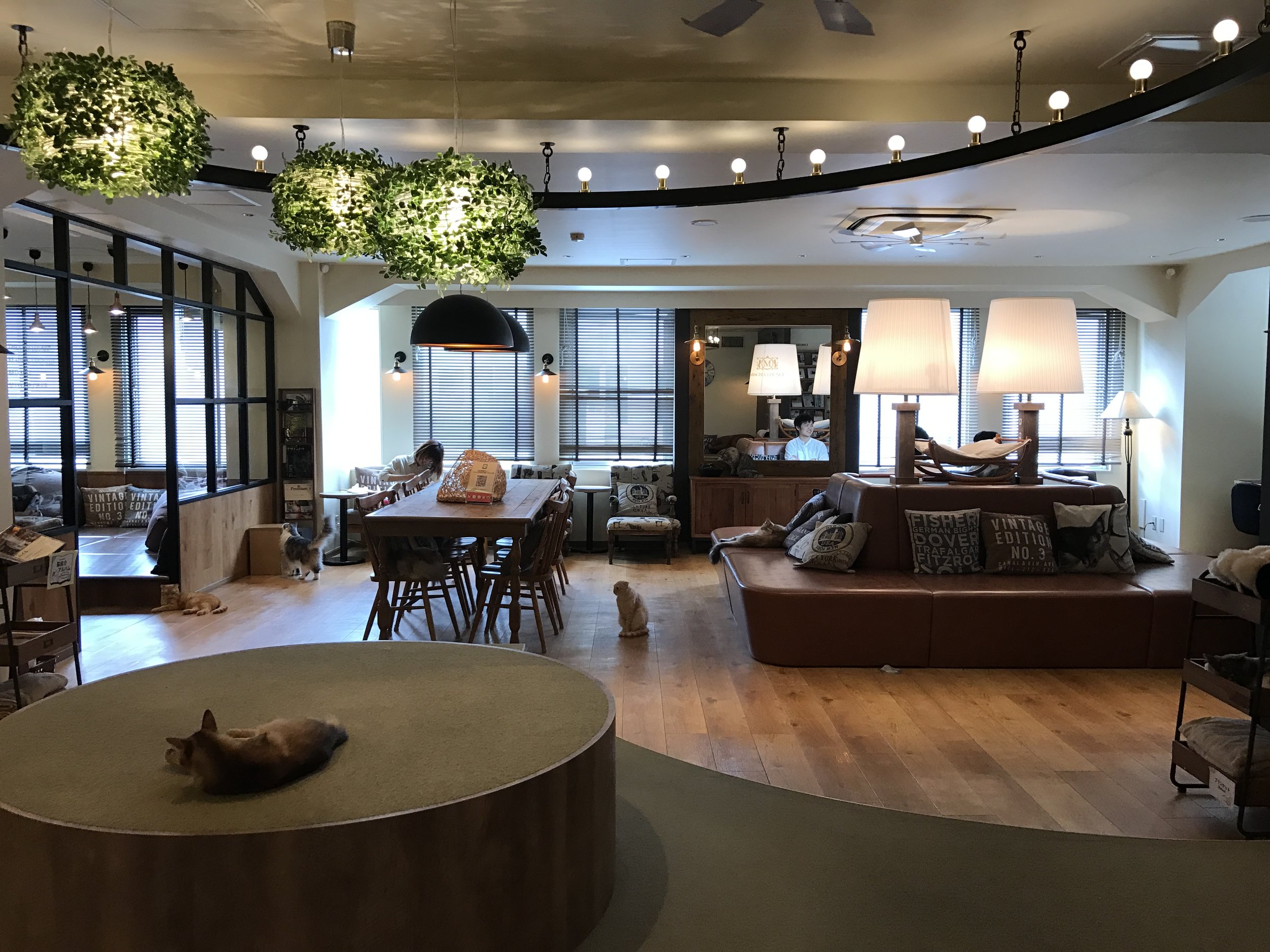What is a Cat Cafe?
Mocha Lounge Ikebukuro, Tokyo, Japan
Zoe, a petite tabby, curiously sniffed my arm, which seemed like a distraction technique, but instead of heading for the whipped cream on top of my decadent chocolate tart, she nudged my hand as if to say ‘Make yourself useful.’ I obliged her with a rub around the ears while taking a sip of Darjeeling tea.
While Zoe and I bonded, I observed the other patrons. Two teens left their sodas untouched as they moved from cat to cat, cooing and petting. A couple, seated in a cozy corner, held hands over a huge white cat that had decided to make their table his nap location. Outside the window, I watched a steady stream of tourists and locals passing by with hands full of Christmas shopping.
It was a late November afternoon in Reims, a city in the Champagne wine region of eastern France, and while it sounds like a typical French café scene, there was one difference.
Ronron Cafe, Reims, France
You see, Ronron is a cat cafe and I’m a cat cafe reviewer.
I’ve gotten more than my fair share of strange looks as people ask me 'What is a cat cafe?', but as someone who has visited more than anyone else in the world (198 in 29 countries and counting) I'm happy to oblige anyone who is remotely curious.
What is a cat cafe?
A cafe is a coffee shop that serves beverages while you sit and visit with a friend, work on your laptop, or just watch the world go by. A cat cafe is essentially the same (Google refers to them as 'themed cafes') except there are cats present. Some cat cafes even offer living room-like areas where you can play with your new kitty friends while enjoying a drink.
Cat Apartment Coffee, Kyoto, Japan
How did cat cafes get started?
The first cat cafe opened in 1998 in Taipei, Taiwan, a cafe called Cat Flower Garden, now known as Cafe Dogs & Cats. While the concept began in Taiwan, Japan popularized it after Japanese visitors brought the idea home and established Japan's first cat cafe, Neko no Jikan in Osaka in 2004. Tokyo's first cat cafe opened in 2005, and the number of cat cafes has exploded since then. Today, Asia leads the way with over 400 such cafes across Japan, Taiwan, China, Thailand, Malaysia, Singapore, Vietnam and Indonesia.
Neko no Jikan, Osaka, Japan
Europe's first cat cafe, Cafe Neko in Vienna, opened in 2012, while Lady Dinah's Cat Emporium in London has become Europe's most famous cat cafe, having been regularly booked up since opening in 2014. Europe is the second largest cat café region with over 100 cat cafes currently open.
Lady Dinah's Cat Emporium, London, United Kingdom
With stricter rules around zoning and foodservice, North America has been slower to embrace the trend, but are nearly caught up to Europe. The first cat cafe, Cat Town, opened in Oakland, California in 2014. Since then, 81 have opened and ten more have announced plans to open in 2019. Canada has sixteen cat cafes and Mexico, three, putting North America’s current total right at 100.
Pounce Cat Cafe + Wine Bar, Charleston, South Carolina
How does it work?
Depending on the cafe's popularity, you may first need to book a reservation online, but the overwhelming majority of cat cafes accept walk ins.
Frequently, but not always, you pay a cover charge for an hour, the fee helps pay for the cats' expenses, vet bills, etc. Sometimes a beverage is complimentary upon payment for your entrance (common in South Korea and Japan) but other times the drinks are charged separately (UK and USA). Continental Europe (France, Germany, etc) do not tend to charge an entrance fee, but instead charge higher prices for food and drink.
Outstanding coffee and cake at Zur Mieze, Berlin, Germany
Food is usually available for purchase, mostly cakes and pastries, although some cafes have a full menu of sandwiches, soups, salads, pasta and more. And no, *exasperated sigh* cats are not on the menu-- but you may be able to purchase cat food or treats to bolster the amount of attention you might receive from the furry 'talent.'
In regard to food consumption at cat cafes, sometimes I hear ‘Ew, isn’t that gross?’ While hygiene standards vary from country to country, generally the food preparation is kept completely separate from where the cats hang out, or even conducted off premises. The cleanliness of most cat cafes is on par with comparable restaurants or cafes, and in some cases even cleaner!
Kitchen at Zur Mieze, Berlin, Germany
Speaking of sanitation, the best cat cafes have rules to keep everyone healthy and happy. You should always wash your hands or use antibacterial gel before you enter. Often, you will need to cover your shoes with plastic booties or remove them for slippers. This keeps things clean and protects the cats from germs brought in by so many visitors.
Another question I frequently hear is ‘Do I bring my cat?’ and the answer is emphatically, NO! A cat cafe is not for cats to visit, but for people to visit cats who reside in the cafe. How many cats can you expect to see at a given cafe? It varies greatly-- anywhere from two to over thirty(!)-- but most cafes have between 8 and 12 cats, which seems a good number such that the cats are social, but not so overcrowded that there is fighting.
Types of Cat Cafes
There are several types of cat cafes based on the cats they have in residence.
Rescues as Permanent Residents
The most common type of cat cafe is one where the cats have been rescued (from the wild or local streets), but live permanently on the premises. This is very typical in Europe, fairly popular in North America, and to a lesser degree, in Asia.
Kissakahvila Purnauskis, Tampere, Finland
Rescues Available for Adoption
Purrington's Cat Lounge, Portland, Oregon
Especially common in North America, these cat cafes frequently partner with shelters and rescue organizations to help socialize and make the cats ready for 'forever' homes. This concept is also very popular in Europe (especially France), but not very common in Asia.
Pedigreed Cats as Permanent Residents
4Rest Norwegian Cat Cafe, Seoul, South Korea
Or as I like to call them ‘posh’ cat cafes. Most popular in Asia, the cats are often purebred felines such as Persians, Exotics, Birmans, Sphinx, Bengals or American Shorthairs with signature markings. Occasionally, you find a cafe showcasing a particular breed, such as Norwegian Forest Cats or Siberians. You can find these cafes occasionally in Europe, but are less common in North America.
Pedigree/Rescue Combination
World's End Girlfriend, Beijing, China
Some cafes start with an owner's purebred cats, and they add a few rescues over time.
Which type makes for a better experience? It really depends on the cats.
I’ve enjoyed many pedigreed cat cafes with their beautiful interiors and equally gorgeous felines, but admit certain cafes have felt a bit soulless, especially when the cats are ‘over it’ in terms of excess human exposure. I've found many rescue cats to be super cuddly, and as a reviewer, tend to value the interactive cat experience more than the physical environment of the cafe. If they serve a decent cup of coffee, I’ll even look the other way if the space is cluttered or has a hint of pet odor. Take that into account if you read my reviews.
What are they like & what do you do there?
The interiors of cafes are incredibly varied, ranging from professionally decorated spaces with great atmosphere to sad, smelly rooms with harsh overhead lighting. Luckily, the majority of cat cafes are lovely places. Most of the time you can find a decent cup of coffee, with a few serving an outstanding cup of joe.
Caturday Cafe, Bangkok, Thailand
Interaction with the kitties cannot be guaranteed, as cats snooze most of the day or may not be in the mood to be petted. Most cafes put the cats' needs first and ask guests not to chase them, pick them up, bother them when sleeping, or use flash photography. Astute cat cafe owners will ideally start by selecting the right cats in the first place.
Roxane, owner of Ronron, says she has specific requirements for the shelters that supply cats to the cafe, mainly that they be social and enjoy being around people. In my conversations with cafe managers, most of them constantly monitor the cats for stress, and if they feel the cat is not happy in the environment, will look to rehome them.
Roxane even goes one step further by requesting cats with short hair or a missing ear that might hinder a cat's desirability in the eyes of those adopting from a traditional shelter. The relaxed environment of the cafe allows these cats to showcase their playful, charismatic, or cuddly side to endear the attention of potential owners.
Tabby Teas Cat Cafe, Sheffield, United Kingdom
But never fear, even if you aren’t in the market for adopting a cat, you can still visit and provide much needed kitty snuggles!
Le Cafe des Chats, Paris, France
Generally, you can be as into the cats as you want to be. Some people like to play with them using toys. Some open their laps to a snoozing feline. Many folks like to take photos. Others prefer to sip coffee and just watch the action. There is no rule that says you need to interact with the cats, and you don’t even need to be a cat lover to enjoy a visit to a cat cafe.
But when sweet Zoe nudges your hand, I suspect you might change your mind.
The Neighbor’s Cat is the alter ego of Paula LaBine, an itinerant cat lover who writes about cat cafes and rescue/adoption/TNR, and has been featured in Miau Magazine, Katzenworld Blog and The Catnip Times. She is currently on a quest to visit every cat café in the world, 200 in 29 countries so far! Find her at theneighborscat.com or on Facebook/Twitter @catcafeviews.















